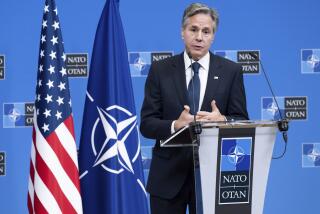Who’d Fight Whom in Europe?
- Share via
“How can tyrants safely govern home,” asked Shakespeare, “unless abroad they purchase great alliance?”
The Soviet Union’s great alliance has been the Warsaw Pact, created by Moscow in 1955 ostensibly as a counterweight to NATO, but more relevantly to legitimize the forward presence of the Red Army and ensure Soviet control over Eastern European military forces. The men, tanks, guns and planes of the six non-Soviet members of the pact are regularly counted as part of the East Bloc’s military assets.
For years, though, the question has been whether Poles, Hungarians, Bulgarians, Czechoslovaks, Romanians and East Germans could be relied on to fight in Moscow’s behalf. The upheavals in Eastern Europe have given a probably definitive answer, with major implications for U.S. and NATO military planning.
The official American view is just starting to reflect the sweeping political changes that are under way. Lt. Gen. Harry Soyster, director of the Defense Intelligence Agency, told a Senate committee with cautious understatement the other day that as a result of recent events, Moscow now has “reduced” confidence in the cohesion of the Warsaw Pact in a military crisis.
A Soviet Union that questions the reliability of its own polyglot forces--care was taken not to send Muslim soldiers to largely Muslim Azerbaijan when the army was moved in to suppress disorders there--must harbor even greater doubts about whether Poles, say, or Czechoslovaks, with their history of anti-Soviet grievances, could be trusted in a conflict.
In fact, Poland, Hungary and Czechoslovakia all have asked that the Soviet troops stationed in their territories be withdrawn within the next year or so. Hungary says that Moscow has agreed in principle. A pullout of all 175,000 Soviet soldiers in the three countries would still leave 380,000 stationed in East Germany. Soviet supply lines to East Germany, though, run through Poland, and it’s hard to believe that Soviet military planners would entrust the safeguarding of those communications to the Poles. The Soviets might try to use that as an argument for keeping the Red Army on Polish soil. But it seems at least as likely that the Soviet military presence in East Germany must in time be reduced, especially since East Germany will probably soon find itself surrounded by non-Communist states.
The changing political landscape in Europe is changing the military map as well. It is far too soon, though, to conclude that the West’s need for military watchfulness has disappeared. The East Europeans have become no more than nominal allies of the Soviet Union, no longer to be counted seriously in the military balance. But great uncertainty still hangs over the future of the Soviet Union itself. Changes are under way that have already markedly reduced international tensions, but the outcome of this momentous internal political drama still is unknown. What has become possible, as U.S. intelligence and military officials agree, is a revised estimate of the military risk in Europe. That risk is diminishing, and with each further withdrawal of Soviet troops from a rapidly de-communizing Eastern Europe, it will likely fall even more.
More to Read
Sign up for Essential California
The most important California stories and recommendations in your inbox every morning.
You may occasionally receive promotional content from the Los Angeles Times.













